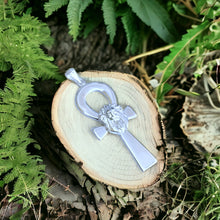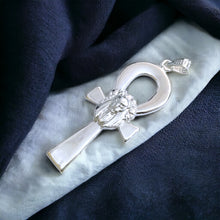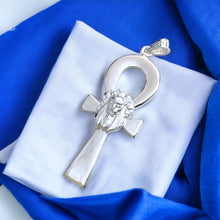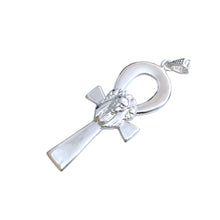
The Silver Goddess Sekhmet Ankh Complex Large Pendant Necklace combines ancient Egyptian symbolism with contemporary design. Inspired by the powerful goddess Sekhmet and the sacred ankh symbol, this necklace embodies strength, protection, and eternal life. Crafted with intricate detail, it pays homage to the rich history and spirituality of ancient Egypt, making it a timeless piece of wearable art.
- History: Inspired by ancient Egyptian culture, Sekhmet is a powerful deity associated with protection and healing.
- Spiritually: Represents strength, courage, and divine protection, drawing on Sekhmet's attributes.
- Talisman: Believed to ward off negativity and offer guidance in times of need.
- Handmade: Crafted with care and attention to detail, each piece is unique.
- Healing: Thought to promote physical and spiritual well-being, invoking Sekhmet's healing energies.
- Material Silver: Made from sterling silver, symbolizing purity and strength.
- Symbolism: Ankh symbolizes life, while Sekhmet embodies power and protection, creating a potent combination.
- How to Wear: Can be worn on any chain up to 5mm in thickness, allowing for versatile styling.
- Ideal Gift: Perfect for someone seeking strength, protection, or a connection to ancient Egyptian spirituality.
History Side For Those Who Are Interested
The Egyptian Goddess Sekhmet Ankh Complex Amulet holds a significant place in the realm of ancient Egyptian religious artifacts, embodying the rich cultural and spiritual heritage of the civilization along the Nile. Sekhmet, often depicted as a lioness-headed deity, was revered as the goddess of war, healing, and protection in ancient Egyptian mythology. The Ankh, a symbol representing life, was deeply intertwined with Egyptian beliefs concerning existence and the afterlife.
The complex amulet featuring Sekhmet and the Ankh symbolizes a fusion of these essential aspects of Egyptian cosmology. Its history intertwines with the religious practices and beliefs of ancient Egypt, reflecting the multifaceted nature of their spiritual worldview.
Origins:
The origins of the Sekhmet Ankh Complex Amulet can be traced back to the New Kingdom period of ancient Egypt (circa 1550–1070 BCE), a time characterized by significant religious and cultural developments. Sekhmet herself was a prominent deity during this era, worshipped for her protective and healing powers, as well as her role as a fierce warrior goddess.
Purpose and Symbolism:
The amulet served various purposes within ancient Egyptian society. Firstly, it was believed to provide protection to the wearer, invoking the power and authority of Sekhmet to ward off evil and illness. Additionally, the presence of the Ankh symbol imbued the amulet with connotations of life, fertility, and eternal existence, underscoring the importance of these concepts in Egyptian religious thought.
Ritual and Usage:
The Sekhmet Ankh Complex Amulet likely played a significant role in religious rituals and ceremonies. It would have been worn by individuals seeking divine protection or as an offering to Sekhmet in temples and sanctuaries dedicated to her worship. The act of wearing such an amulet was seen as a way to invoke the blessings and favor of the goddess, particularly in times of need or uncertainty.
Cultural Significance:
Beyond its religious significance, the amulet also holds cultural importance within the context of ancient Egyptian society. It reflects the intricate interplay between religion, magic, and daily life in the civilization, illustrating the profound impact of belief systems on all aspects of Egyptian culture.
Legacy:
The legacy of the Sekhmet Ankh Complex Amulet endures through the ages, preserved in archaeological discoveries and scholarly research. It serves as a tangible link to the religious beliefs and practices of ancient Egypt, offering insights into the complexities of their worldview and the enduring appeal of Sekhmet as a powerful and multifaceted deity.
In conclusion, the Sekhmet Ankh Complex Amulet stands as a testament to the rich tapestry of ancient Egyptian spirituality, embodying the enduring legacy of Sekhmet and the Ankh symbol in the hearts and minds of those who revered them.























